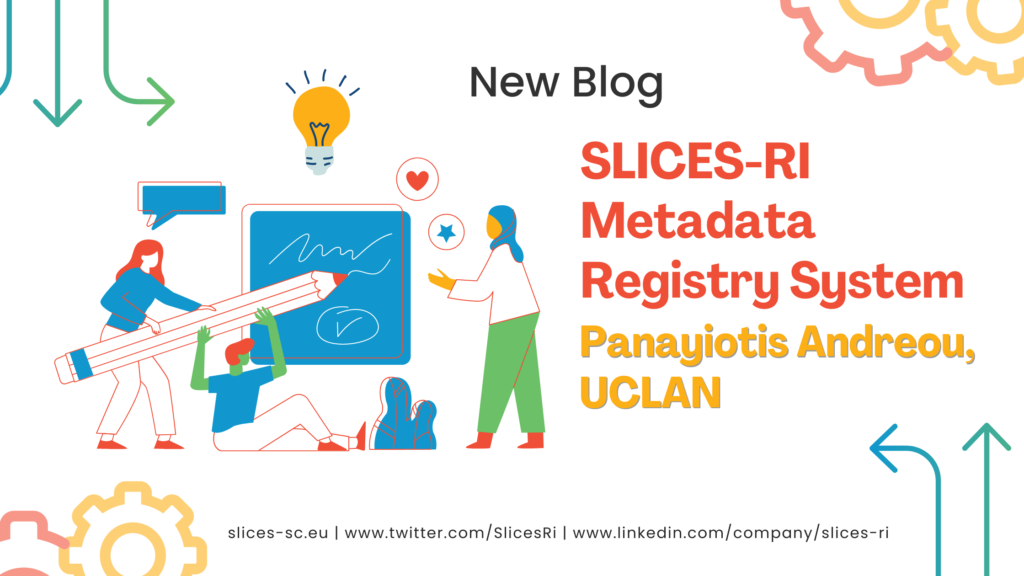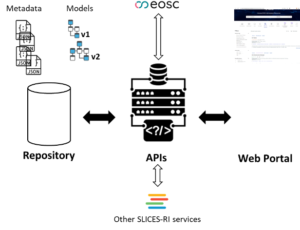SLICES-RI Metadata Registry System

SLICES-RI is a platform that’s designed to provide an all-encompassing experiment experience for researchers, enabling seamless access to specialized laboratory equipment, facilitating collaboration and interdisciplinary research, and fostering and accelerating innovation. One of the key enablers for SLICES-RI to accomplish its vision is the design of appropriate data sharing and integration mechanisms to support complex experiments that orchestrate heterogeneous geo-diverse resources. In addition, data managed within SLICES-RI need to adhere to the FAIR data principles enhancing the discoverability, accessibility, interoperability, and reusability of research data, thus promoting a more efficient and collaborative scientific ecosystem.
SLICES-RI fully endorses and adopts the FAIR principles, acting as a catalyst to enable and foster cutting edge research, data-driven science and scientific data-sharing. SLICES-RI, allows its users (and interoperating platforms) to uniformly find, and access any object, such as data, services and software. To achieve this, SLICES defines a metadata profile scheme, where each digital object is first described using a select set of common metadata attributes and then according to its type, the description is extended with a set of type- specific attributes. Each managed digital object, coined SLICES FAIR Digital Object (SFDO), provides a list of predefined options to inform metadata consumers of what kind of object it describes. The metadata is structured in a hierarchical format, with Level 1 containing attributes that are common to all SFDOs. Level 2 contains the metadata specific to the type of the Digital Object. Some types also support recording additional domain-specific information, based on the object’s subtype, which is recorded in level 3.
To achieve this, SLICES defines a metadata profile scheme, where each digital object is first described using a select set of common metadata attributes and then according to its type, the description is extended with a set of type- specific attributes. Each managed digital object, coined SLICES FAIR Digital Object (SFDO), provides a list of predefined options to inform metadata consumers of what kind of object it describes. The metadata is structured in a hierarchical format, with Level 1 containing attributes that are common to all SFDOs. Level 2 contains the metadata specific to the type of the Digital Object. Some types also support recording additional domain-specific information, based on the object’s subtype, which is recorded in level 3.
The Metadata Registry System (MRS) provides access and management services to SFDOs using three components:
- Repository: The metadata itself is persisted in an open source database. The current implementation employs PostgreSQL due to its extensive feature set, reliability track record and widespread familiarity.
- Backend: The backend is the core of the system. It exposes the metadata to the rest of the world in form of a REST API and facilitates aspects such as access control, reporting, etc. A core feature of the backend is that it acts as a translation layer, allowing backwards compatibility when a new version of metadata models is released. Finally, it handles background maintenance tasks, such as European Open Science Cloud (EOSC) import/export. The backend is implemented using ASP.NET Core. While it is designed to be as independent as possible, the authentication is delegated to SLICES-global Authentication and Authorization Infrastructure (AAI) to ensure uniform user access across the entire infrastructure.
- Web portal: The web portal allows user-friendly access to the MRS functionality. Users can search for objects, manage objects (if they have permissions) and access reporting facilities, such as dashboards. The web portal is accessible to all registered users.
Currently, the first version of MRS was released as part of the new blueprint version.
